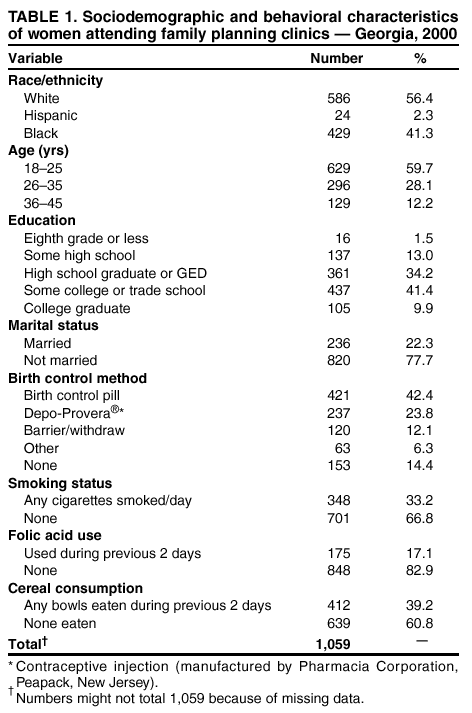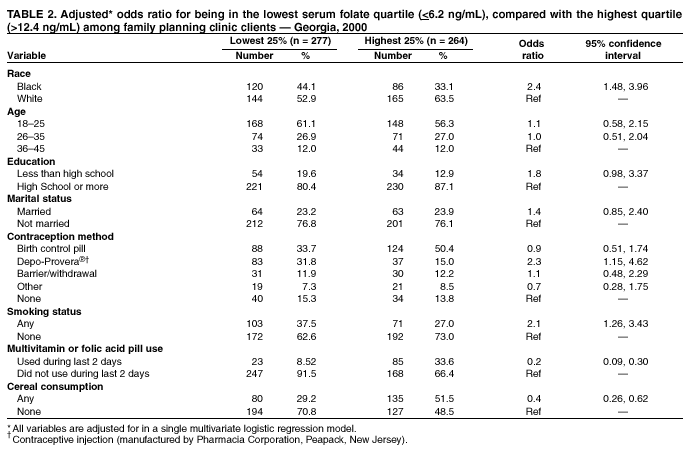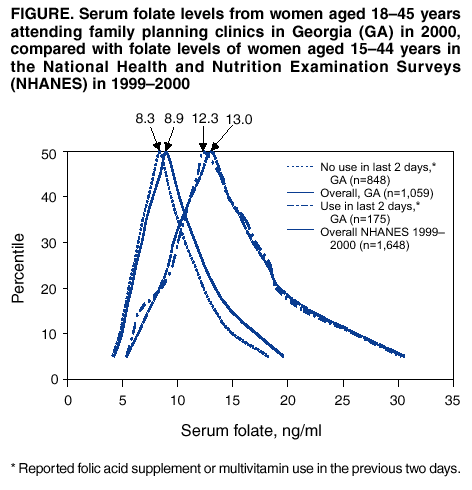 |
|
|
|
|
|
|
| ||||||||||
|
|
|
|
|
|
|
||||
| ||||||||||
|
|
|
|
|
Persons using assistive technology might not be able to fully access information in this file. For assistance, please send e-mail to: mmwrq@cdc.gov. Type 508 Accommodation and the title of the report in the subject line of e-mail. Serum Folate Levels Among Women Attending Family Planning Clinics --- Georgia, 2000Prepared by SummarySince 1998, serum folate levels have increased nationally after mandatory fortification of cereal grain products with folic acid. Whether serum folate levels have increased among all women has not been well-studied. Identifying characteristics of women with lower serum folate levels would also be helpful in designing educational campaigns. Data for this report were collected during January 2000--January 2001. During 2000, blood samples were collected from 1,059 women aged 18--45 years who attended six family planning clinics in Georgia and analyzed for serum folate levels. This sample included women aged 18--25 years (60%), black women (41%), and women who had a high school education or less (49%). The median serum folate level (8.9 ng/mL) among this population was lower than the median of women of childbearing age (13.0 ng/mL) who participated in the 1999--2000 National Health and Nutrition Examination Survey (NHANES). In logistic regression analysis, women who were black (odds ratio [OR] = 2.4; 95% confidence interval [CI] = 1.48, 3.96), who smoked (OR = 2.1; 95% CI = 1.26, 3.43), or who used Depo-Provera® contraceptive injection (manufactured by Pharmacia Corporation, Peapack, New Jersey) (OR = 2.3; 95% CI = 1.15, 4.62) were more likely to be ranked in the lowest quartile (<6.2 ng/mL) of serum folate concentrations when compared with the highest quartile (>12.4 ng/mL). Women who consumed cereal regularly (OR = 0.4; 95% CI = 0.26, 0.62) or folic acid supplements (OR = 0.2; 95% CI = 0.09, 0.30) were the least likely to be in the lowest serum folate quartile. This study indicates that certain women are at greater risk for having lower serum folate levels, including women who are black, smokers, Depo-Provera users, and those less likely to eat cereal regularly or to take folic acid supplements. In Georgia, these data are useful in defining target populations (e.g., black women and smokers) for folic acid education campaigns because public health officials can develop contextually appropriate messages and outreach approaches for targeting women for folic acid interventions. Ongoing surveillance of serum folate status among women can guide future intervention efforts. IntroductionNeural tube defects (NTDs), which are serious birth defects of the brain and spinal cord, affect approximately 4,000 pregnancies each year in the United States (1). Epidemiologic studies demonstrate that folic acid, when taken in adequate amounts periconceptionally, can prevent 50%--70% of NTDs (2). During 1992, the U.S. Public Health Service (USPHS) recommended that all women of childbearing age take 400 µg of folic acid to help prevent neural tube defects (2). During 1996, as a way to increase consumption of folic acid among women of childbearing age, the Food and Drug Administration mandated that, effective January 1998, synthetic folic acid be added to enriched cereal grain products (3). Reports from the 1999 National Health and Nutrition Examination Survey (NHANES) demonstrates that serum folate levels among childbearing age women have increased after fortification. Median serum folate levels increased from 5.2 ng/mL in NHANES III (1991--1994) to 13.0 ng/mL in NHANES 1999--2000 for women aged 15--44 years (4). Whether serum folate levels have risen equally among all women is not yet known. Certain women might still be at an increased risk for having a pregnancy affected by an NTD as a result of inadequate folic acid intake. Serum folate data from subpopulations of women seeking routine clinical services would be helpful in assessing
whether inadequacies exist. In addition, identifying characteristics associated with women who have low serum folate levels would
help in designing educational interventions targeted at those with greatest need for higher folic acid consumption. In this study, we report serum folate levels of women before their participation in a folic acid intervention evaluation study in Georgia
family planning clinics during 2000. Only limited studies postfortification have examined serum folate levels among populations in the United States (5,6). This study attempts to identify a group of women at high risk for low folic acid intake.
The question used to assess folic acid intake was, "In the last 2 days, did you take a folic acid pill or multivitamin?" We used multivariate logistic regression to compare women in the lowest serum folate quartiles
(<6.2 ng/mL) with women in the highest serum folate quartile (>12.4 ng/mL).
The median serum folate level for the 1,059 study participants who attended family planning clinics was 8.9 ng/mL (range: 1.6--164.0 ng/mL) for the overall sample. Women who reported using a folic acid pill or multivitamin during the previous 2 days had a median level of 12.3 ng/mL (range: 3.4--164.0 ng/mL), and women who reported no use during the previous 2 days had a median serum folate level of 8.3 ng/mL (range: 1.6--34.1 ng/mL) (Figure). The serum folate distribution from a nationally representative sample, NHANES 1999--2000, has a median of 13.0 ng/mL, a value that is similar to the median for the women in the Georgia sample who reported either taking a folic acid supplement or a multivitamin during the 2 days preceding the visit (Figure). Women in this sample were primarily aged 18--25 years (60%); 41% were black; 42% used oral contraceptives; 33%
were smokers; and the majority were not married (Table 1). In the adjusted logistic regression model, women who had serum folate levels in the lowest quartile were more likely to be black, use
Depo-Provera® contraceptive injection (manufactured
by Pharmacia Corporation, Peapack, New Jersey), smoke, and report not eating breakfast cereal or using a folic acid pill
or multivitamin during the 2 days preceding the visit (Table 2).
When compared with serum folate levels in a nationally representative sample (NHANES 1999--2000), the median in this sample of women attending Georgia family planning clinics during 2000 was substantially lower (4). These findings are also inconsistent with findings of improved folate status among other subsets of the U.S. population postfortification (5,6). The population of Georgia women in this study differs from the 1999 NHANES population (representative of the U.S. population) by certain characteristics that could explain the lower serum folate levels. For example, the women who participated in the Georgia family planning clinics were more likely to be young, black, and unmarried compared with other U.S. women aged 18--45 years. Possibly, these women differ in their nutritional practices, which could result in differences in serum folate levels when compared with a national sample. During 2000, approximately 34% of women aged 18--45 years reported taking folic acid daily (9). In this sample, only 17% reported taking folic acid during the previous 2 days. The 2000 Gallup poll sample included 21% women aged 18--24 years and only 11% black women (9). In contrast, this sample had a greater proportion of women who were aged 18--25 years (60%) and black (56%). In addition, only 6% of family planning clinic patients reported, "planning to get pregnant in the next few months or next year." Folic acid consumption might be viewed by these women as a behavior associated with pregnancy planning. Because the majority of the women in our sample were not planning pregnancies, they might not have been immediately receptive to the folic acid message and, therefore, might have been less likely to currently take folic acid. Moreover, benefits of the intervention could be delayed until women begin to think about pregnancy. Multivariate analysis demonstrated that women who smoked or used Depo-Provera were twice as likely to be ranked in the lowest quartile of serum folate concentrations than in the highest quartile. Previous research has indicated that smokers have substantially lower serum folate levels than nonsmokers (9,10). However, reports of the association between oral contraceptives and serum folate levels are inconsistent (11,12), and no study has examined the effects of injectable hormones (e.g., Depo-Provera) on serum folate levels. No substantial difference in serum folate status was identified for women taking oral contraceptives. The findings regarding smoking and contraceptive use might be a reflection of inherent differences among these women (e.g., differences in their metabolic characteristics) as well as related to their behavior. This analysis also demonstrates that folic acid use, through a folic acid supplement/multivitamin or breakfast cereal, is associated with higher serum folate levels and is an effective method for raising serum folate levels. Misclassification of folic acid consumption could have occurred because asking about folic acid consumption during the previous 2 days could have excluded those women who did not consume folic acid during the previous 2 days but were usually habitual consumers. However, when controlling for habitual use, defined as taking a multivitamin >4 times during the previous week, similar estimates resulted. This study is subject to certain limitations. It was designed as part of a folic acid intervention evaluation study and, therefore, questions concerning other behavioral characteristics of the participants were limited. We were unable to collect any information regarding the women's dietary habits other than cereal consumption, which could explain differences in serum folate levels among this group. Other limitations include the low participation rate (60%). Requesting samples of blood might have been a deterrent to participation. The limited sample size limits the conclusions that can be drawn from this study. Further research is needed to determine the reason for these associations between serum folate levels and race, smoking, and injectable contraceptives. Serum folate is a valid measure of folate consumption, but it might not be directly predictive of the risk for NTDs. One strength of the study includes the use of CDC's laboratory that processed both the NHANES 1999 and Georgia blood assays. Using the same laboratory reduced the number of errors resulting from variances in laboratory techniques. Although serum folate levels have increased in the aggregate national population, certain populations have lower folate levels. Because contraceptive methods are not 100% effective, all women capable of becoming pregnant, regardless of
pregnancy intention or current birth control use, should consume adequate amounts of folic acid for preventing NTDs in their children. Targeting specific populations (e.g., women attending family planning clinics) who might be at higher risk for NTDs because of lower folic acid levels can be an effective strategy for continuing to reduce NTDs in the United States.
Table 1  Return to top. Table 2  Return to top. Figure  Return to top.
Disclaimer All MMWR HTML versions of articles are electronic conversions from ASCII text into HTML. This conversion may have resulted in character translation or format errors in the HTML version. Users should not rely on this HTML document, but are referred to the electronic PDF version and/or the original MMWR paper copy for the official text, figures, and tables. An original paper copy of this issue can be obtained from the Superintendent of Documents, U.S. Government Printing Office (GPO), Washington, DC 20402-9371; telephone: (202) 512-1800. Contact GPO for current prices. **Questions or messages regarding errors in formatting should be addressed to mmwrq@cdc.gov.Page converted: 8/30/2002 |
|||||||||
This page last reviewed 8/30/2002
|